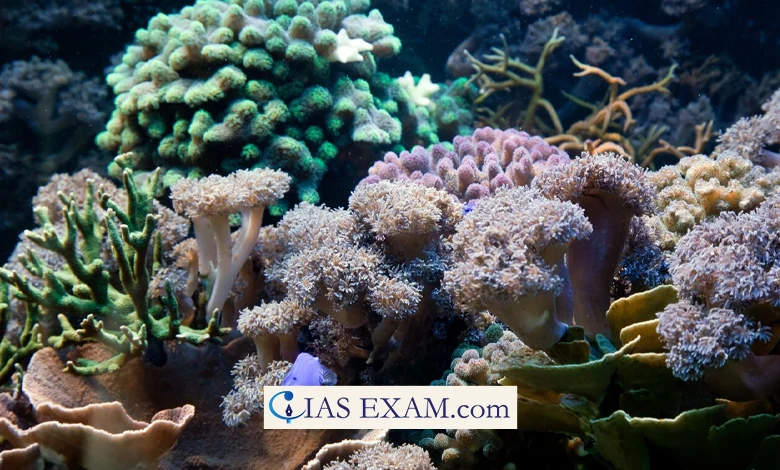Coral bleaching in Lakshadweep
Syllabus: Environment and Ecology [GS Paper-3]

Context
Lakshadweep, a union territory in the Arabian Sea, is home to one of the most diverse and vibrant marine ecosystems in the world. However, this ecosystem is facing a significant threat from coral bleaching, which has severe consequences for the entire ecosystem. This article will explore the causes, effects, and consequences of coral bleaching in Lakshadweep and discuss the measures being taken to mitigate this threat.
Key Points of Coral bleaching in Lakshadweep
- Marine Heatwaves and Bleaching in Lakshadweep
-
-
- Lakshadweep island is meeting with warm periods for more than five months from the month of October 2023.
- The sea surface temperatures reach high, which causes coral bleaching. These are very severe due to the fact that coral reefs provide refuge, breeding, and feeding ground for thousands of species of marine life and act as vital barriers from waves, currents, and cyclones.
- ICAR-Central Marine Fisheries Research Institute (CMFRI) reported that coral reefs present in Lakshadweep Strait have gone under severe bleaching due to these heat wave conditions.
- The survey of several Lakshadweep islands unanimously highlighted that Lakshadweep Island hard coral species have been robustly impacted.
- If the water temperature doesn’t drop this long term bleaching event may lead to the death of Lakshadeep’s corals.
-
- Degree Heating Week (DHW) Indicator
-
-
- Scientists resort to the Degree Heating Week (DHW) index to quantify the extent of heat stress resulting from the sustained increase in temperature over a specific area over a period of 12 weeks.
- When sea water temperatures go beyond their mesothermal maximum by a degree, corals start feeling thermal stress.
- If the extreme temperatures continue, this can make the stress worse for the patient.
- In Lakshadweep, the intensive hot wave has brought very bad pressure to the coral reef, resulting in bleaching.
-
- Unprecedented Scale
-
- While Lakshadweep has seen coral bleaching events in the past (1998, 2010, and 2015), the current one is unprecedented in scale.
- Urgent conservation efforts are needed to protect these fragile ecosystems and prevent further damage.
Coral Bleaching
- Coral bleaching is a process during which corals get exposed to severe stress, the result of which is that they expel the algae that are inside their tissues, thereby turning them white.
- The cause is probably due to factors like water temperature rise, pollution or getting too much sunlight.
- Bleaching is a natural process of corals, but the frequency and severity of these events have reached alarming rates because of climate change, with the bleaching events occurring more often and severely.
Causes of Coral Bleaching in Lakshadweep
Lakshadweep’s coral reefs are facing unprecedented threats from coral bleaching. The main causes of coral bleaching in the region are:
- Climate change has triggered the rise in sea temperatures, something which has serious implications on living things.
- ElNiño events which usually focus on the heating water anomaly.
- Land-based pollutants and debris can be a source of marine pollution.
- With less water clarity, there will be an increase in sunlight exposure because of the higher chance of water penetration.
Effects of Coral Bleaching on Lakshadweep’s Marine Ecosystem
Coral bleaching has severe consequences for Lakshadweep’s marine ecosystem, including:
- Loss of biodiversity: The coral reefs have as the setting for a very varied life-form, many which feed from the corals and take refuge in them.
- Decreased fish populations: Coral reefs are of paramount importance for the living of many different fish types and consequently that is the basis of their local fishing.
- Economic impacts: Coral bleaching, an event that directly and negatively affects the tourism industry, which is the major element of Lakshadweep economy.
Measures to Mitigate Coral Bleaching
To address the threat of coral bleaching, various measures are being taken, including:
- Establishment of marine protected areas to reduce human impact
- Coral reef restoration efforts through coral nurseries and reef rehabilitation
- Research and monitoring programs to better understand and predict bleaching events
- Awareness campaigns to educate local communities and tourists about the importance of coral conservation
Conclusion
Coral bleaching poses a significant threat to Lakshadweep’s marine ecosystem, with far-reaching consequences for biodiversity, the fishing industry, and the local economy. The prolonged marine heatwaves in Lakshadweep have caused severe coral bleaching, threatening the diverse marine ecosystems of the region. Immediate action is crucial to safeguard these valuable coral reefs.
Source: The Indian Express
UPSC Mains Practice Question
Q. What are the primary factors contributing to coral bleaching in the Lakshadweep region, and what measures can be implemented to mitigate its impact on the marine ecosystem?





.png)



